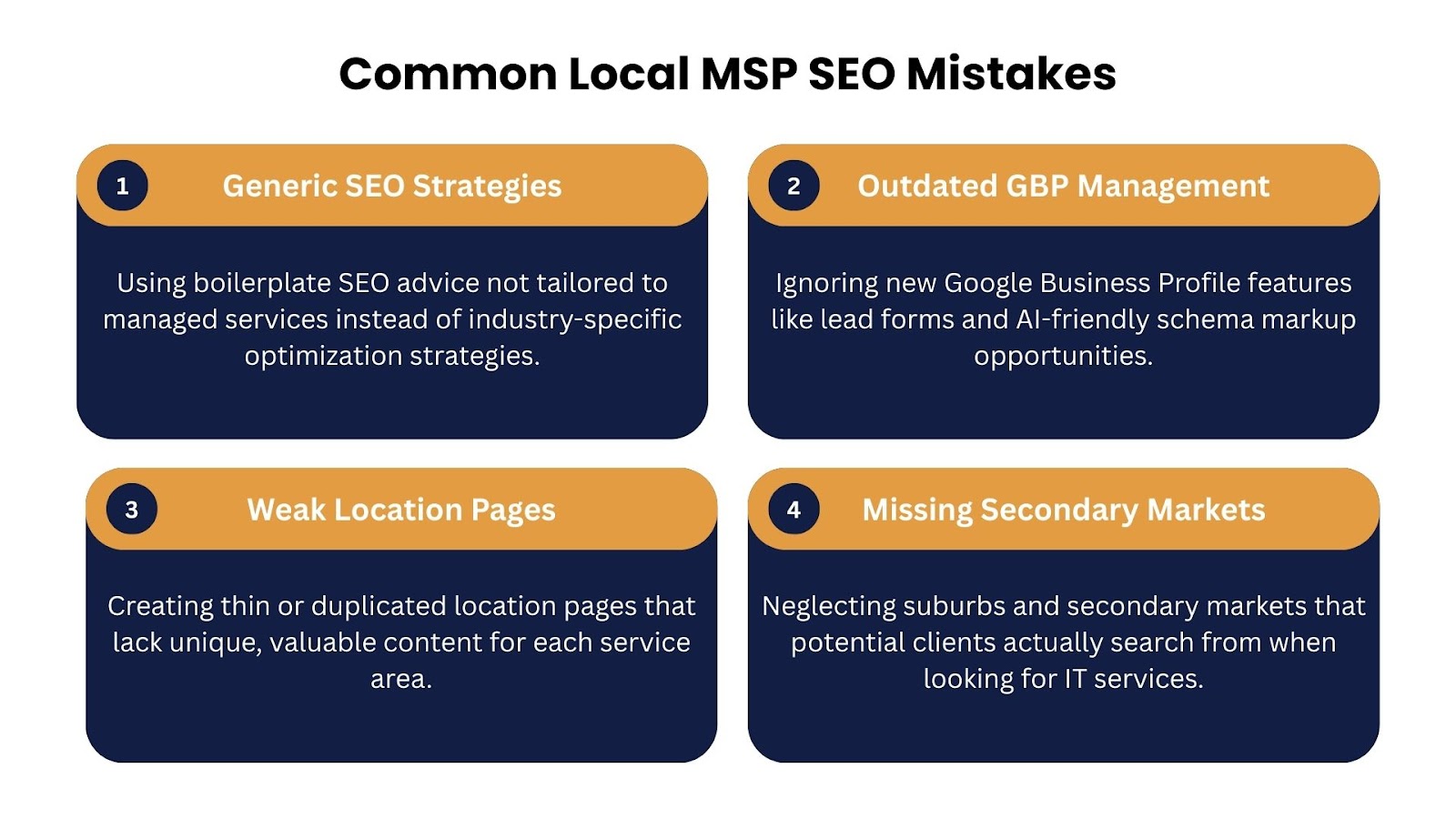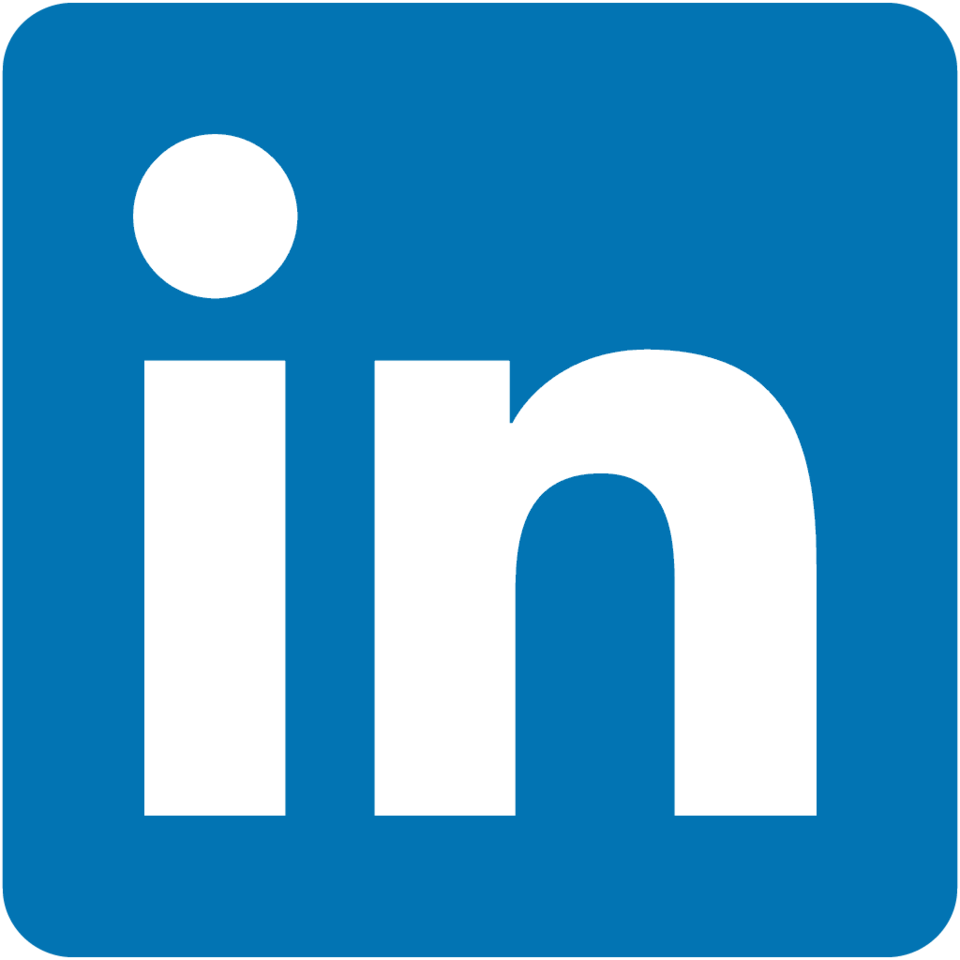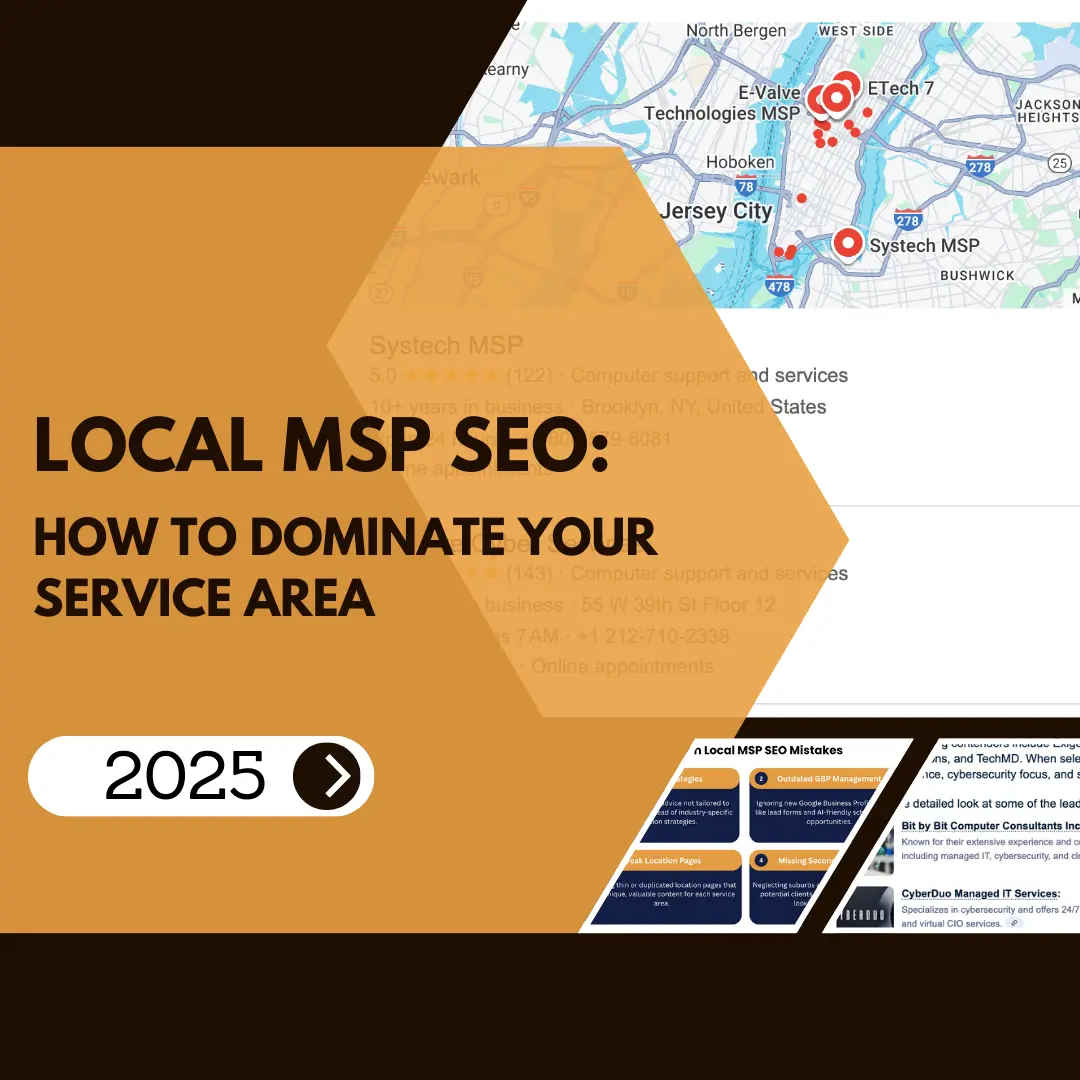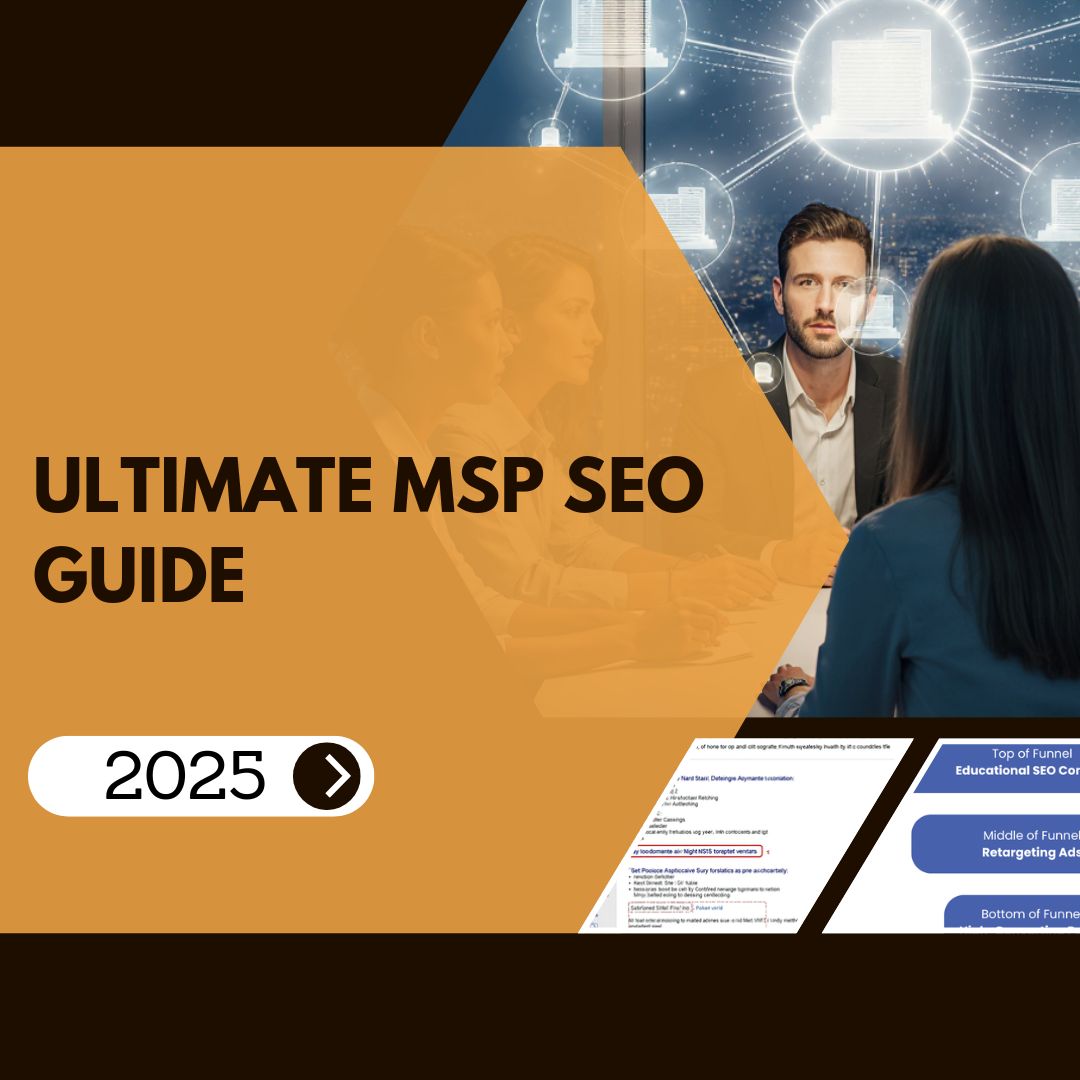Local MSP SEO: How to Dominate Your Service Area in 2025?
In 2025, local search for MSPs is more competitive than ever. With technology evolving rapidly, local MSP SEO has become the single most reliable way to generate high-intent leads in your area.
Nearly 72% of service-related searches start on Google, and over 80% of users click on local results. Combine that with the rise of AI-driven overviews and voice search, and you’ve got a landscape where visibility equals credibility.
In this guide, we’ll walk you through both quick-win tactics and the long-term strategies needed to secure top spots in local search, especially the map pack and AI-generated snippets, so you can dominate your MSP’s service area in 2025.
Why Local SEO Matters More for MSPs in 2025
With AI Overviews and Google’s Search Generative Experience (SGE) surfacing answers at the top of search, organic listings are getting pushed down. Local MSP SEO isn’t the same as a year before. News publishers have seen traffic drops as high as 40% due to AI summaries. However, local businesses with accurate listings and strong reviews still stand out. Voice searches now account for ~20% of mobile queries, and 72% of consumers use voice to find local businesses.
Bottom line: If your MSP isn’t optimized for local search in all its evolving forms, traditional, AI-driven, and voice, you’re invisible to a large chunk of potential customers. Contact MSP SEO Agency and get fast results or follow the steps below and you will optimize your website for local search results.
The Core Building Blocks of Local MSP SEO (2025)
1. Optimize your Google Business Profile for conversions
Most MSPs treat GBP like a directory listing. In 2025, it’s your mini-website in Google, and it can (and should) generate calls and form fills on its own.
Start with your primary category (usually “IT Support Service”) and add relevant secondary categories like “Computer Security Service,” “Computer Consultant,” or “Data Recovery Service,” depending on what you actually sell. Then complete every field as if it were your homepage: services, service area, business hours (including holiday hours), booking/consult links, and messaging.
Use the newer features that push action, not just views:
- Service menus: list offer names customers understand (e.g., “Managed IT for 10-100 seats,” “Microsoft 365 Administration,” “24/7 Help Desk”).
- Lead forms & messaging: route inquiries straight to sales. Add a short auto-reply that sets expectations (“Thanks, our team replies within 15 minutes, Mon–Fri 8-6.”).
- Q&A: seed 3-5 real questions with concise answers (“Do you support hybrid Microsoft/Google environments?” “What’s your SLA?”). This content often shows in AI and voice results.
- Posts: treat these like micro-landing pages, one service, one city, one CTA.
Pro tip: Time-boxed or local posts (e.g., “Free ransomware risk scan for Glendale businesses this week”) tend to earn 2-3× more engagement than generic updates. Add a phone CTA and UTM tags to track calls and clicks.
Quick checklist
- Primary + secondary categories locked ✔
- Services populated with plain-language names ✔
- Lead form/messaging on ✔
- Q&A seeded ✔
- Three fresh posts published this month ✔
2. Build high-converting service-area & location pages
Rule #2 of local MSP SEO: Your service pages shouldn’t read like copy-paste city swaps. Each page needs to answer: “Why choose you in this city?”
Structure that converts:
- Hero with the city front and center: “Managed IT Services in Glendale - Fast, Friendly, Fixed-Price.”
- Pain → Promise: name two local pain points (e.g., “slow response,” “shadow IT”) and how you solve them.
- Services snapshot tailored to the city’s common stack: “Microsoft 365, network hardening, compliance help for clinics.”
- Local proof: a short case study, a client quote, logos, or a mini-map showing your response radius.
- Conversion block: click-to-call, “Schedule a 15-min fit call,” or a short form. Keep it above the fold and repeat near the bottom.
- FAQs written in natural language, great for voice/AI queries.
- Next steps: “Prefer email? Get a pricing sheet in your inbox.”
Add structured data (LocalBusiness + Service) so Google and AI systems understand who you serve, where, and how to contact you. If you cover multiple suburbs, build one strong page per area rather than one bloated “we serve everywhere” page.
Watch out: Duplicate city pages with only the location swapped will get ignored. Aim for 20-30% unique content per city (different proof, FAQs, industries, and examples).
3. Nail your local keyword strategy
This isn’t about stuffing “MSP” everywhere. It’s about matching how buyers actually search when something breaks, or before it does.
Your core clusters:
- Geo + service: “managed IT services in Dallas,” “IT support Chicago,” “cybersecurity service in Tempe.”
- Problem/intent: “ransomware recovery near me,” “set up Microsoft 365 shared mailboxes,” “HIPAA IT compliance support.”
- Time/urgency: “24/7 IT help desk near me,” “same-day network support.”
Map one primary keyword to each page (GBP, city pages, core services) and sprinkle 2–3 close variations where it makes sense. Use your GBP insights, Search Console, and call transcripts to find the phrases people actually use (“printer won’t connect,” “Teams call quality issue,” “guest Wi-Fi security”).
Pro tip: Include business-type modifiers buyers use: “IT support for dental clinics in Austin,” “MSP for construction companies Denver.” Those terms convert like crazy and face less competition.
4. Get authoritative local links
Local MSP SEO authority still moves the needle. Your goal is to earn real links from real local organizations, the places your prospects already trust.
High-yield targets:
- Chambers & business groups (membership + directory listing + speaking slots)
- Tech meetups & conferences (sponsor, speak, publish the recap on your blog)
- Partners & vendors (Microsoft/Google partner directories, VOIP providers, cybersecurity vendors, swap case studies and link each other)
- Local universities & nonprofits (volunteer equipment refreshes, cybersecurity workshops)
Simple outreach you’ll actually send:
Subject: Support for [Event/Group] from a local MSP
Hi [Name],
I run an MSP here in [City]. We love what you’re building with [Event/Group] and would be happy to support, sponsorship, a practical “protect your network in 30 minutes” mini-talk, or helping recap the event on our site and yours.
If that’s useful, I can send a short outline.
- [Your Name], [Company], [Phone]
Pro tip: When you guest speak, publish the slides and a recap on your site first; then offer the group a condensed post that links back to the full version. That’s an easy, legitimate local backlink.
5. Manage reviews like a sales tool
Reviews aren’t vanity, they’re conversion assets and a direct local ranking signal. The goal is a steady, believable review velocity, with specifics that future buyers care about (response time, friendliness, issue resolution).
Build a review engine:
- Trigger requests after ticket closure via email/SMS with a direct GBP link.
- Tell customers what to mention: “If this was helpful, would you mind noting speed and communication in your review?”
- Rotate who you ask (new clients, projects, help-desk solves) to keep it natural.
Respond to everything
- Positive: call out the tech by name and the specific job (“Glad Alex got your Team's call quality fixed within the hour!”).
- Negative: acknowledge, fix, and follow up publicly. One Phoenix MSP turned a 2-star into a retained contract by posting a same-day remedy and giving a clear prevention plan. That thread now closes deals because it shows how they operate under pressure.
Copy-paste-ready reply templates
- Positive: “Thanks, [Name]! We’re thrilled [Tech] could sort [issue] fast. If anything pops up, reply here, we’re on it.”
- Negative: “[Name], you’re right, this missed our standard. We’ve [specific fix] and assigned [Tech] to monitor it this week. I’ve DM’d you my direct line so we can make this right.”
Pro tip: Repurpose your best Google reviews on your city pages and proposals (with first name + industry). Social proof in the right place = more booked calls.
Your Main Takeaways
If you do nothing else in local MSP SEO this quarter: tighten your GBP for conversions, publish one truly useful city page, map keywords to intent, earn one real local link, and get five detailed reviews. Those five moves alone will put you ahead of most MSPs in your market, and set you up for the 2025 shifts in AI, voice, and the map pack.
We also have conducted a complete MSP SEO guide which we suggest too read to understand 2025 strategies and how you can grow your business with data-driven and strategic SEO.
2025 Local SEO Trends MSPs Can’t Ignore
1. AI Overviews & Search Generative Experience (SGE)
Google’s SGE now delivers AI-written answers before the map pack even appears. If your business info isn’t structured, review-rich, and consistent across all listings, you’ll miss out on those high-visibility spots. Done right, this means more qualified leads, stronger niche authority, and less dependence on paid ads.
2. Generative & Answer Engine Optimization (GEO & AEO)
These are the new frontiers of SEO, optimizing so AI systems can easily “cite” your content. That means clean formatting, context-rich explanations, and technical elements like llms.txt files. The payoff? Your MSP shows up inside AI answers instead of fighting for traditional organic clicks.
3. Authentic, Human Content
With AI spam flooding search results, Google is rewarding content that feels, and is, genuinely human. Use AI as an assistant, not a replacement. Layer your real-world expertise, client stories, and local insights over any AI draft to stand out.
4. Voice Search & Hyperlocal Targeting
MSP voice searches are often urgent and conversational: “Hey Siri, find IT support open now.” Build pages and FAQs that match that tone, full questions, natural phrasing, and location-specific answers, so you’re the one Siri or Google Assistant calls up first.

Common Local MSP SEO Mistakes in 2025
Your 2025 MSP Local SEO Action Plan
Timeframe
Actions
This Week
Update GBP categories & service menus, request 5 new detailed reviews.
1–3 Months
Deploy location pages, run local outreach for links, optimize content for GEO/AEO.
6–12 Months
Expand into nearby cities, integrate AI-driven content workflows, monitor AI visibility.
Conclusion
The era of local MSP SEO in 2025 demands adaptability. The path to dominating your service area is through strategic optimization across AI-aware content, voice search, and local authority signals. Start today with your audit, leadership in search waits for no one.






.webp)
